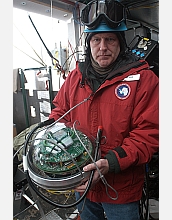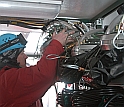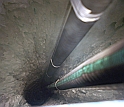

Media Advisory 06-010
Polar Neutrino Observatory Takes a Big Step Forward

March 21, 2006
For still images contact Peter West. For B-roll of IceCube drilling operations at NSF's Amundsen-Scott South Pole Station and animations of the nature of neutrinos, contact Dena Headlee at (703)292-7739.
During the recent austral summer, an international team of scientists and engineers took a major step forward in building a subglacial instrument known as IceCube, which is designed to detect high-energy subatomic particles called neutrinos. The team harnessed a sophisticated hot-water drill to install hundreds of basketball-sized optical modules in the South Pole ice sheet that will eventually form a detector encompassing a cubic kilometer of ice.
Through a joint project of its Office of Polar Programs and its mathematical and physical sciences directorate, NSF is contributing more than $240 million to the international partnership that is building the $272-million detector. Germany, Sweden and Belgium are also contributing to the project. The University of Wisconsin-Madison is leading the drilling and science operations.
Neutrinos are created in galactic collisions, distant black holes, quasars and a host of the most violent events in the cosmos. When fully operational, IceCube will use 4,200 light-sensing modules to sample neutrinos from the sky in the Northern Hemisphere, using the Earth as a filter to exclude other types of neutrinos, such as those from the Sun.
Once the holes are drilled, 1.5-mile (2.5-kilometer) cables holding the spherical digital optical modules--which are composed of electronics for sensing light and circuit boards for gathering and processing data--are frozen in place. The modules detect evidence of neutrinos when they collide with other particles. The devices then relay data to the surface where the information is processed and stored for analysis.
The IceCube project is an international collaboration of scientists from more than 30 scientific organizations and more than a dozen U.S. universities.
-NSF-

Media Contacts
Terry Devitt, University of Wisconsin (608) 262-8282 trdevitt@wisc.edu
Images/B-Roll
Peter West, NSF (703) 292-7761 pwest@nsf.gov
Dena Headlee, NSF (703) 292-7739 dheadlee@nsf.gov
Related Websites
The University of Wisconsin Icecube website: http://icecube.wisc.edu/

The National Science Foundation (NSF) is an independent federal agency that supports fundamental research and education across all fields of science and engineering, with an annual budget of $6.06 billion. NSF funds reach all 50 states through grants to over 1,900 universities and institutions. Each year, NSF receives about 45,000 competitive requests for funding, and makes over 11,500 new funding awards. NSF also awards over $400 million in professional and service contracts yearly.
 Get News Updates by Email Get News Updates by Email
Useful NSF Web Sites:
NSF Home Page: http://www.nsf.gov
NSF News: http://www.nsf.gov/news/
For the News Media: http://www.nsf.gov/news/newsroom.jsp
Science and Engineering Statistics: http://www.nsf.gov/statistics/
Awards Searches: http://www.nsf.gov/awardsearch/
|






